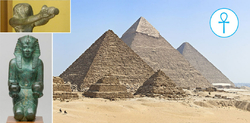- Retour accueil
- Vous êtes ici : Blog The Pyramids of the Cold The Pyramids of the Cold Section 6 • Inclined Well : The Taweret Lady of the Well sealing block
The Pyramids of the Cold Section 6 • Inclined Well : The Taweret Lady of the Well sealing block
Publié par Bruno Coursol dans The Pyramids of the Cold le 12/04/2022 à 20:12
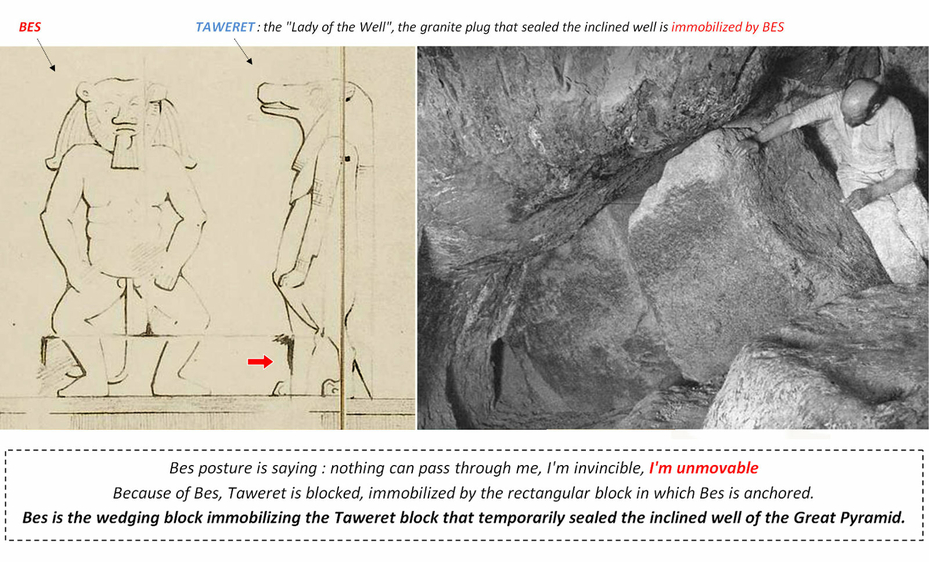
The Pyramids of the Cold - Section 6 • Inclined Well : the Taweret Lady of the Well sealing block
In summary : goddess of Childbirth Taweret is a glorifying metaphoric representation of the upper granite plug of the Great Pyramid of Giza. Because Taweret is referring to the granite block that was the sealing block at the bottom of the inclined well, and would have been permanently underwater, Taweret had been personified into an hippopotamus : a huge semiaquatic animal that loves to stay, walk and even sleep completely submerged underwater.
Some of Taweret's epithets are "the Lady of the Well", and "She Who Removes Water".
Taweret and Bes (the wedging block that maintained Taweret in place during the operation period of the pyramid) were associated with chilbirth, because of the way these two blocks were involved into the draining procedure of the well through a drain hole : the metaphor is about the water breaking.
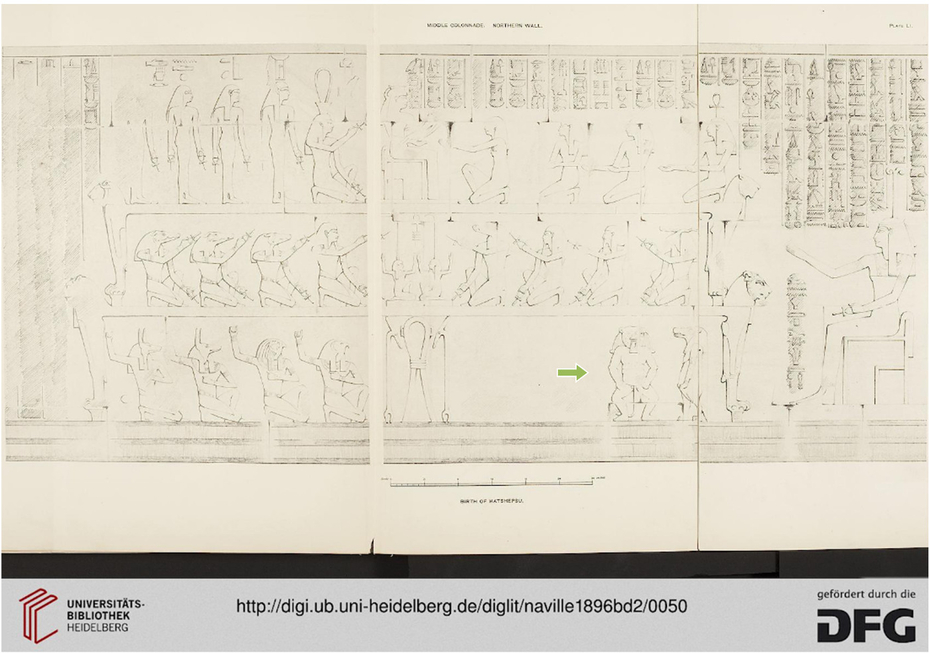
Hatshepsut’s birth scene, from Édouard Naville "The Temple of Deir el Bahari" (London, 1896), vol. 2, pl. 50. Image courtesy of the University Library Heidelberg : The Ebony shrine, northern half of the middle platform. https://digi.ub.uni-heidelberg.de/diglit/naville1896bd2/0050
6.01 The Hatshepsut’s birth scene, from Édouard Naville "The Temple of Deir el Bahari"
I really didn't expect to find any kind of proof that would validate the fact that the Taweret block was maintained in its position for the time being of the operating of the Great Pyramid, by a wedging block , but not only the immobilized Taweret/Bes scene is that proof and Bes that particular wedging block, but also we have to note the position of that scene within the entire relief : it is located at the very end of the story.
Whatever the story is exactly, the scene showing that Taweret was blocked by Bes is at the very end of it.
We can imagine 2 different approaches :
1 • Time related approach : the story ends up when it is time for Bes to break and stop immobilizing Taweret. It would be the end of the operating period of the pyramid.
2 • Space related approach : this is a plan of the entire ascending passage that starts with the Grand Gallery and the 4 crewmembers of one hauling beetle, and end with the Taweret/Bes couple at the bottom of the flooded part of the first ascending passage : the inclined well.
Between the 4 crewmembers and the Taweret/Bes couple, there is a bizarre empty space, but again it can be interpreted with both approaches : time and space related.
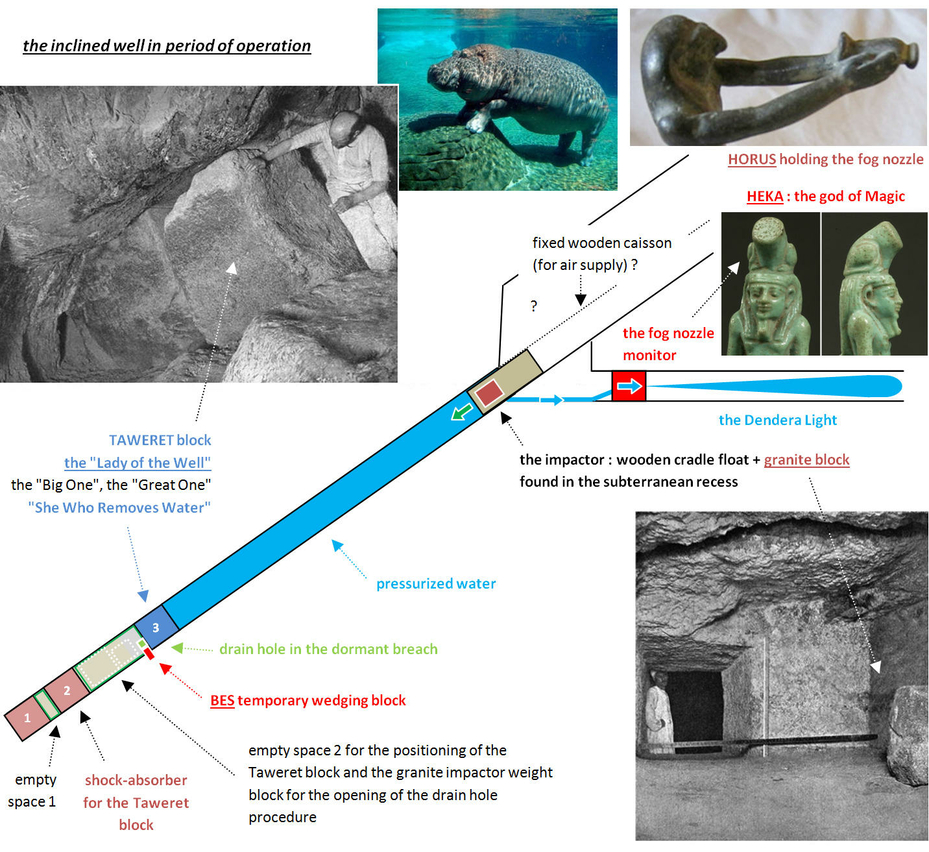
The inclined well of the Great Pyramid of Giza, during its operation period, showing the Taweret granite sealing block and the small Bes granite wedging block.
6.02 Taweret and the water breaking metaphor
The draining of the inclined well would have result in a huge amount of water gushing out of the bottom of the well after the upper granite plug had moved down and revealed the breach. The metaphor with the water breaking is the origin of the Taweret goddess of childbirth.
"In Ancient Egyptian religion, Taweret is the protective ancient Egyptian goddess of childbirth and fertility. The deity is typically depicted as a bipedal female hippopotamus with feline attributes, pendulous female human breasts, the limbs and paws of a lion, and the back and tail of a Nile crocodile.[...] She commonly bears the epithets "Lady of Heaven", "Mistress of the Horizon", "She Who Removes Water", "Mistress of Pure Water", and "Lady of the Birth House" [...] The name "Taweret" (Tȝ-wrt) means "she who is great" or simply "great one". Source : https://en.wikipedia.org/wiki/Taweret
As clearly said by Anneke Stracke in her thesis "The Hippopotamus of Deir el-Medina", goddess Taweret was clearly associated with water :
Excerpt from page 30 of her thesis : "Of the twelve objects within this catalogue that include hieroglyphic epithets of Taweret… three of them make clear mention of her role as a goddess of water. While it is not unthinkable that a hippopotamus goddess should be associated with water, it is still quite unusual that a quarter of all epithets of the goddess which survive from Deir el-Medina feature this role so heavily. The epithets preserved in Deir el-Medina refer to “the pure water”, “lady of the well” and “Taweret, who is in the midst of the purification waters of Nun”. https://studenttheses.universiteitleiden.nl/access/item%3A2624829/view
In short, some of Taweret's epithets are : "the Lady of the Well", "the Big One", "the Great One" and "She Who Removes Water", and she is referring to the upper granite plug (block #3).
In other words, Taweret is the upper granite plug : "The Great One", "The Big One", "The Lady of the Well" and "The One Who Removes Water".
The fact that both Bes and Taweret, as the wedging block and the sealing of the well block, were both associated with the draining of the well, explains why both were associated with childbirth : the metaphor is about the water breaking.
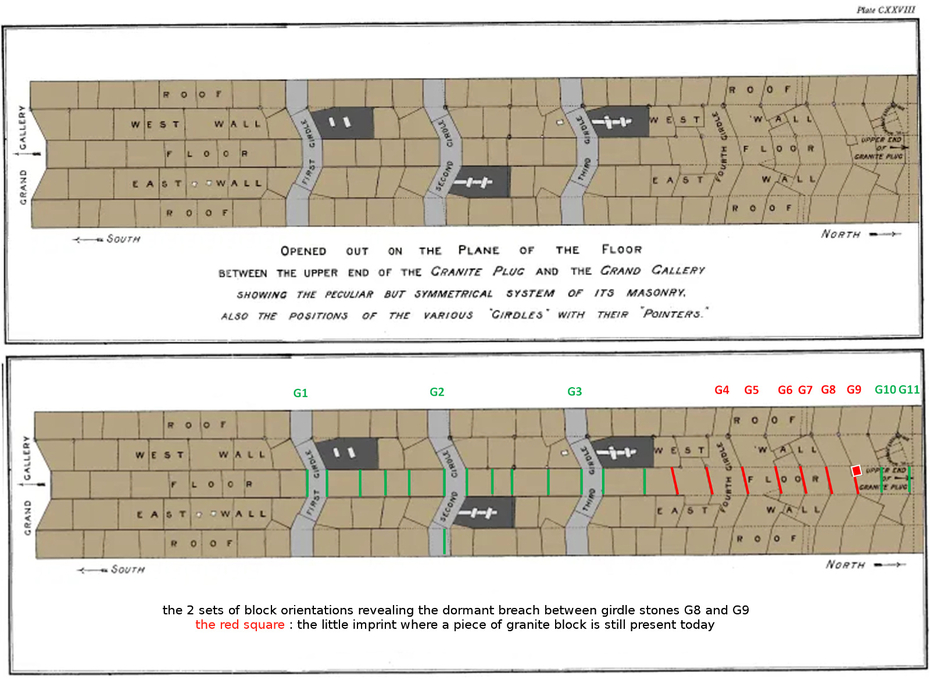
The ascending passage of the Great Pyramid of Giza showing the little imprint with a small block of granite still present today and that was the anchor for the Bes wedging block.
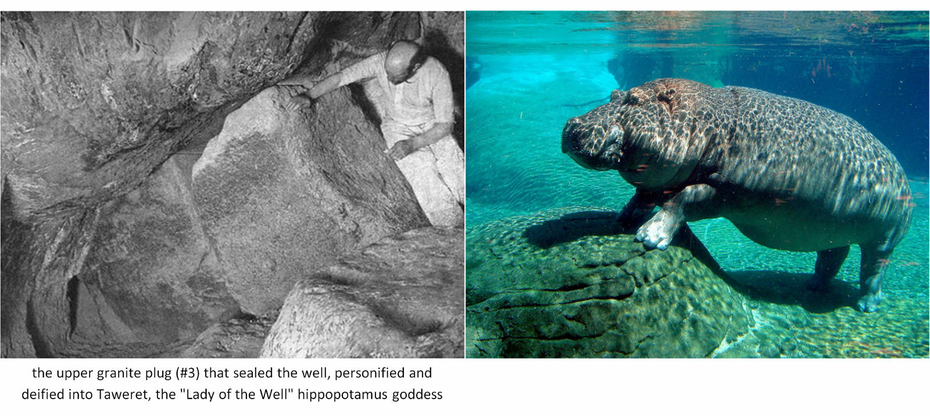
The upper granite plug of the Great Pyramid of Giza was the sealing block of the inclined well. This block had been glorified into the "Lady of the Well" Taweret goddess and represented into the hippopotamus, a huge semiaquatic animal that loves to stay, walk and even sleep completely submerged underwater.
6.03 The completely worn out upper granite plug is Taweret : the "Lady of the Well"
If you compare the two blocks appearing on the above photograph from the Edgar brothers, you can immediately see that if the lower block (this is the middle plug #2) looks like new, this is not true for the upper block that appears completely worn out.
Also its upper face looks curved, like something was stuck to it, but maybe this is only an illusion.
This Taweret block had a story completely different from the other granite plugs. The only logical explanation about the fact it appears so worn out, is that this block, and only this one, did moved or should I say forced its passage, on a short distance. It only could have been on a short distance, because many Egyptologists said that farther away up, the dimensions of the ascending passage wouldn't allow the block to pass through.
It is important to say that this upper block #3 would have only move a few meters and that it would have been most probably forced to do it by the huge pressure caused by the "explosive" opening of the King's chamber : if I am right about this, the man inside the grotto, not only triggered the last release of the impactor, but the impactor itself triggered the opening of the chamber.

6.04 Why goddess Taweret is represented as an hippopotamus
When the Great Pyramid was operational and the ascending passage flooded to form an inclined well, in the continuation of the Grand Gallery's central gutter, the upper granite plug was sealing the well.
Consequently, this sealing block would have been permanently underwater : it explains why ancient Egyptians chose to personify this block into the hippopotamus : a huge semiaquatic animal that loves to stay, walk and even sleep completely submerged underwater.
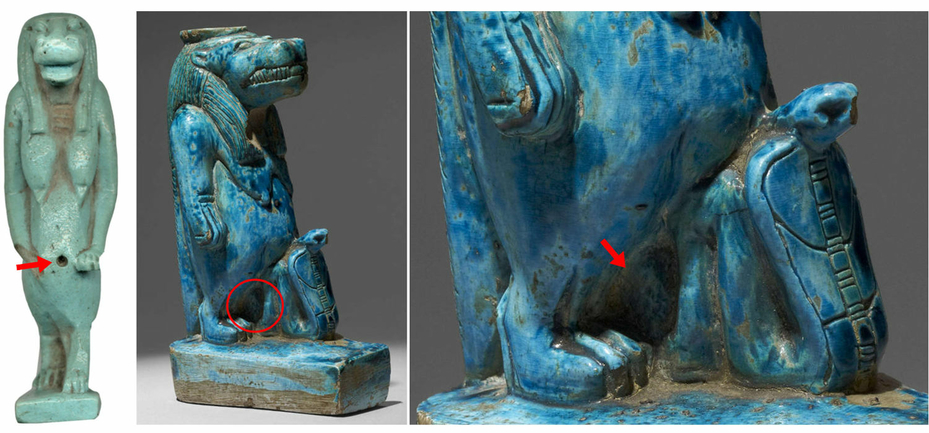
Taweret giving birth to snakes = Taweret giving birth to water (the water breaking metaphor).
6.05 Taweret : the "Lady of the Well" and "She who Removes water"
EA11862 from the British Museum is a very unusual figure that is depicting Taweret "giving birth" to a snake. To my knowledge, this is the only representation of Taweret associated with a snake.
We've seen in the previous post that snakes in ancient Egypt, were representations of the water from the annual inundation of the Nile : the very first snake is created by Hapi himself (relief of the Philae temple).
Here, with Taweret, we have the representation of the "last" snake, so to speak : Taweret is the representation of the draining of the inclined well that preceded the final shutdown procedure of the Great Pyramid.
Another outstanding figure of Taweret is the amulet 48.1555 from the Walters Art Museum, in Baltimore : it is the only figurine I know of Taweret that is revealing that the Sa sign is actually set on the figure so it is hiding from view a "secret pouring hole".
Amulet of the Goddess Taweret 48.1555 from the Walters Art Museum, Baltimore : https://art.thewalters.org/detail/11051/amulet-pendant-of-taweret/
Blue glazed steatite figure of Taweret and a snake EA11862 from the British Museum : https://www.britishmuseum.org/collection/object/Y_EA11862
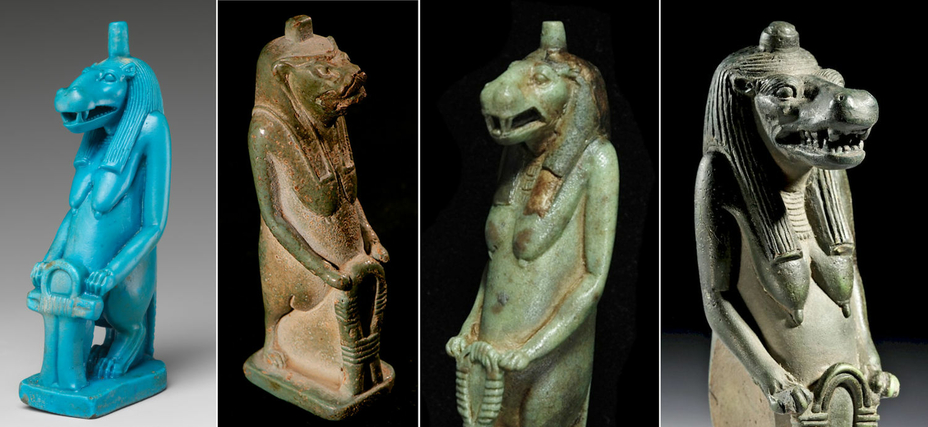
Tthe emblem that Taweret is wearing on her head is the wedging block that maintained her into position before the draining of the well procedure. That emblem is Bes, the wedging block of the well.
6.06 The small granite block that was set in the floor imprint between the G8 and G9 girdle stones
In my opinion, the emblem that is showing Taweret on her head is the granite wedging block that was set on the floor of the ascending passage/inclined well, right between the G8 and G9 girdles.
Academic explanation is that this emblem is probably a "mast" that would have been needed to put a special headdress. But if you look at the last above photograph of a Taweret figure from the Artemis Gallery, in Louisville (CO), the "mast" is way to tiny to do the job. This cannot be a supporting "mast".
More about the Bes wedging block in the next Section.
Accession Number: 26.7.1193 from the Metropolitan Museum in New York : https://www.metmuseum.org/art/collection/search/544864
Glencairn Museum's Taweret figurine E66. Late Period : https://glencairnmuseum.org/newsletter/september-2014-the-goddess-taweret-protector-of-mothers-and.html
Faience Statuette of Taweret Ref.1352 from Christoph Bacher Archäologie Ancient Art, Vienna : https://www.cb-gallery.com/en/produkt/fayence-statuette-der-taweret/
Artemis Gallery, Louisville CO : https://www.bidsquare.com/online-auctions/artemis-gallery/impressive-detailed-egyptian-faience-votive---taweret-1396924
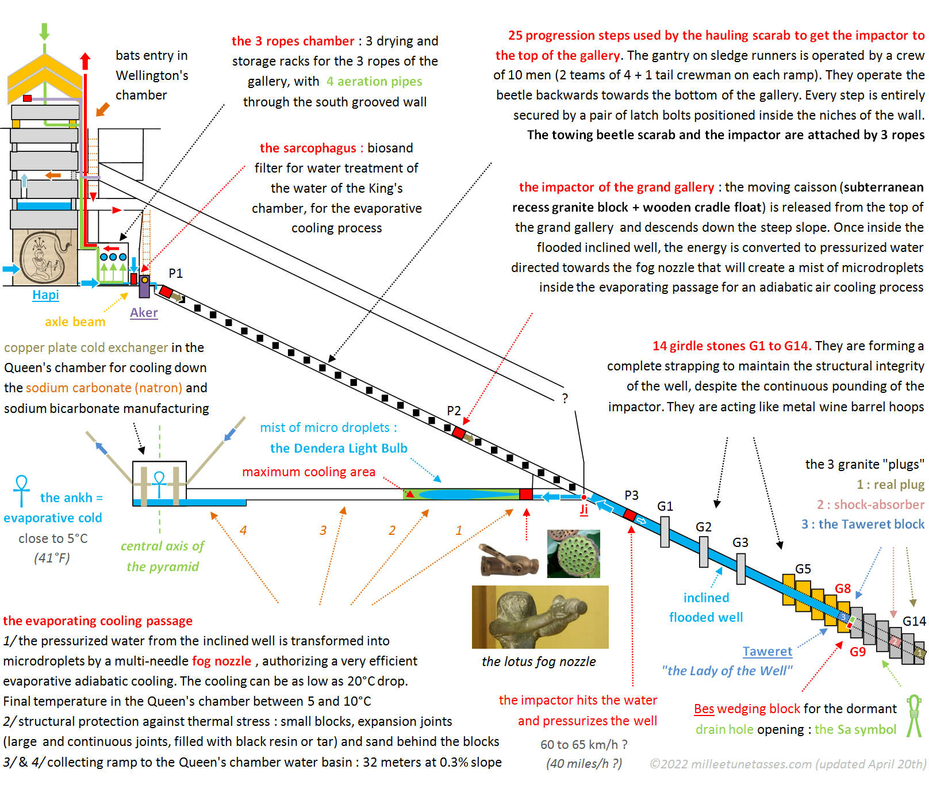
Diagram of the Great Pyramid of Egypt in operation, before the shutdown procedure and the draining of the inclined well.
6.07 Summary of the study : hidden behind the academic vision of the ancient Egyptian religion, a vast number of metaphors are describing some of the most advanced science and technological knowledge of that time : ancient Egyptian gods were nothing else than pharaohs' metaphoric self-glorifications of their theoretical and experimental scientific accomplishments in physics and chemistry.
Pharaohs used the power of Science to legitimate themselves as kings of Egypt : they forged an entire religion, based on science to rule their kingdom, and they presented that science as Magic.
The end game of this technological program that probably started on the very first Dynasty, was the Great Pyramid of Giza where evaporative cooling was engineered in the known part of the pyramid from the pressurized water produced in the inclined well, known today as the ascending passage.
The evaporative cold simply took advantage of the power of water, and was most probably necessary to cool down chemical manufacturing of sodium carbonate and sodium bicarbonate produced by an ammonia-soda Solvay process, as suggested by the very strong ammonia smell and the limestone kiln in the so-called burial chamber of the Red Pyramid. At that time, sodium carbonate was called natron, and it was the salt used for the mummification of the pharaohs (Sections 14, 15 and 16).
The cooling seems to have represented the most difficult part of the process, as suggested by the Step Pyramid's official name : according to scholars, the very first pyramid complex, the Step Pyramid of Djoser, was called "the refreshment of the Gods". No doubt that a more accurate translation would certainly be "the cooling of the Gods".
It means that ancient Egyptians were the first civilization to master a Solvay-like process for sodium carbonate manufacturing, long before it got reinvented in the 1800's in Europe. The key elements of that process is the temperature control of the chemical reactions (the cooling), and the dome shaped plate necessary for the counterflow chemical reactions to occur in an efficient way. That counterflow reaction plate is what really is the disc of Sabu.
As shown with Akhenaten and Nefertiti, the creation of the evaporative cold was the most sacred accomplishment of all (Section 17), and this is exactly what the Dendera Light is all about : the Dendera Light is the fog of microdroplets of liquid water that evaporates and creates the cold. Talking about the snake inside the Dendera Light Bulb : "The field surrounding Ra’s snake form is referred to in ancient Egyptian literature as protective magical energy in liquid form that all gods and pharaohs possess" (Faulkner, Section 2).
Everything that had been done in the Great Pyramid of Giza inspired most of the ancient Egyptian religion, and it had been glorified into what we know today as the Underworld.
The Underworld is referring to the chambers and passages of the Great Pyramid of Khufu, and in particular to the Grand Gallery where a hauling gantry beetle operated a wooden coffin shaped impactor that had a small nested granite block inside it. The impactor generated endlessly, over and over, maybe every 15 minutes the pressurized water that was then transformed into a fog of microdroplets inside the horizontal cooling passage.
The Grand Gallery of the Great Pyramid where the act of hauling was done, is the "Secret Hauling Cavern of the Underworld" described in the Amduat "Book of the Hidden Chamber".
The most important chamber of the Great Pyramid wasn't the King's chamber that only was the main water tank of the pyramid, but the Queen's chamber, the only one on the central axis of the pyramid. Because the Queen's chamber was inaccessible from the rest of the pyramid, it was glorified into the "Hidden Chamber of the Underworld" (Section 11), and because the Queen's chamber was the coolest place in the pyramid (about 5°C / 41°F), and with a constant 100% Humidity rate, this chamber was the one where the biggest amount of very hard salt encrustation had been documented by the first explorers of the pyramid in the 1800's and before it had been removed in 1998 by Zahi Hawass (Section 1). Very hard salt encrustation is the signature of the evaporative cooling process, even nowadays.
The most incredible thing is that pretty much everything I've just said, actually appears in one single myth, but it doesn't originate from ancient Egypt : it is the "Churning of the Ocean" Hindu myth that produces the immortal nectar Amrita. The fact is that the endless churning of water that ends up with the production of an elixir that gives eternal life, is exactly what were doing ancient Egyptians in the inclined well : natron was the salt used for the mummification of pharaohs.
Natron gave eternal life to pharaohs, just like the Amrita (Section 19).
Poster un commentaire

